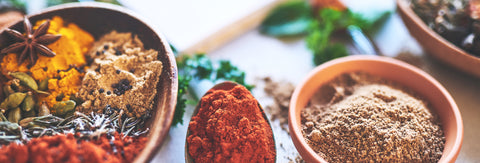Spending more time than usual in your kitchen? To learn more about the spices stuffed in your cupboard, below are 5 commonly used herbs, and the health benefits they may provide.
Cinnamon
Many people think of cinnamon for baking sweets, but medicinal texts dating back to 2000 B.C. in China, reference cinnamon as a naturopathic remedy. There is actually more than one type of cinnamon; cassia cinnamon is made from the dried inner bark of an evergreen tree grown in areas of southeastern Asia, while Ceylon cinnamon is made from the bark of the tropical evergreen tree Cinnamomum verum, which grows mainly in Madagascar, southern India and Sri Lanka. The cinnamon spice in your cupboard may contain a combination, but cassia cinnamon is the most common in North America.[1]
Health Canada states that both types of cinnamon:
- Provide antioxidants.
- Are used in Herbal Medicine for digestive disturbances/indigestion, such as mild spasms/cramps of the gastrointestinal tract, bloating and flatulence.
- Are traditionally used in Herbal Medicine for loss of appetite[2].
Cassia (Cinnamomum Aromaticum) has the additional health claim of helping “to support/maintain healthy blood glucose levels.”[3] Yet you would need between 3 - 6 grams of dried bark daily, which is much more than you are likely to sprinkle over your latte. If you are looking for this health benefit, you would not only need to ensure the correct dosage, but also the correct species of cinnamon.
Garlic
Garlic is one of the most cultivated herbs worldwide. It is believed that garlic was native to Siberia, but over 5000 years ago began to spread to other regions of the world.[4] Many people love to cook with garlic, but did you know it has a number of health benefits? Health Canada states that garlic is:
- Used in Herbal Medicine to help reduce elevated blood lipid levels (high cholesterol) and maintain cardiovascular health in adults.
- Traditionally used in Herbal Medicine to help relieve the symptoms associated with upper respiratory tract infections and nasal congestion.[5]
You can also take it supplementally for the health benefits, without the bad breath.
Ginger
Ginger is used in baking, as well as in many meals. The ginger root found in your local grocery store, is actually from a perennial plant which grows leafy stems with yellowish green flowers. Native to warmer parts of China, India and Japan, ginger is now cultivated in parts of Africa, the Middle East and South America as well.[6]
As a child, your parents may have given you ginger ale when you were sick. There is something to that, although most pop currently available does not contain actual ginger. According to Health Canada, ginger is:
- Traditionally used in Herbal Medicine to help relieve digestive upset, including lack of appetite, nausea, digestive spasms, indigestion.
- Used to help prevent nausea and vomiting associated with motion sickness, and/or seasickness.
- Traditionally used in Herbal Medicine as an expectorant and cough suppressant to help relieve bronchitis as well as coughs and colds.[7]
Oregano
Fresh and dry oregano leaves are used in all types of foods from baked goods, to vegetables, to fish and meat; Although in Canada it is best known for pizza and pasta sauces. Oregano is a perennial herb which grows to between 1-3 feet tall and has olive-green leaves and purple flowers. Along with basil, lavender, marjoram, mint, sage and thyme, it is part of the Lamiaceae family. Native to the warm-temperate Mediterranean region (as well as other western and southwestern regions of Europe), oregano has now been cultivated across the world. The variety of these growing conditions can affect the specific active parts of the essential oil it contains.
Oregano has been used medicinally since the ancient Greek and Roman empires. Now we know that carvacrol, a phenol found in the essential oils of oregano, is the main active component.[8] Carvacrol provides not only the pungent smell, but also the health benefits of being an antioxidant.[9]
Turmeric
Turmeric is a spice derived from the roots of the tropical plant Curcuma longa Linn, which is a member of the ginger family. Turmeric is one of the main spices included in most curry sauces, providing not only flavour, but its bright yellow / orange colour. That bright colour comes from pigments known as curcuminoids. Curcumin is the most common curcuminoid found in turmeric and is considered its most active medicinal component. Turmeric is used as a spice, a food colouring, and has been traditionally used for a number of medicinal purposes.[10] According to Health Canada turmeric is:
- Used in Herbal Medicine to aid digestion.
- Used in Herbal Medicine as an anti-inflammatory to help relieve joint pain.
- Used in Herbal Medicine as a liver protectant.[11]
Try Something New In The Kitchen
Enjoy being creative in the kitchen, trying out new recipes with these 5 herbs and all the others available to you. They can help bring an exciting new flavour to family favourite meals. But keep in mind that the dosage amounts required to receive the full Health Canada listed claims above, would be much higher than you would usually cook a meal with. The exact plant species the herb comes from makes a difference as well. This is why when it comes to supplemental herbs, quality matters.
Why Quality Matters
Jamieson uses TRU-ID®, a Canadian, independent DNA certification program founded by the University of Guelph. It uses the latest in DNA technology to verify the correct identity of herbal species. Jamieson is going above and beyond Health Canada quality requirements, as currently the required tests are for what shouldn’t be in an herbal product, such as micro-contaminates and heavy metals. Although that is important, we also want to ensure we have the correct herbs included in the bottle. The TRU-ID® symbol is a scientific confirmation that the herbal species expected, is actually present in the bottle. This provides you with an assurance of receiving the health benefit expected.
[1] Natural Medicines. Cassia Cinnamon Professional Monograph. Accessed March 23, 2020 at: https://naturalmedicines.therapeuticresearch.com/databases/food,-herbs-supplements/professional.aspx?productid=1002
[2] Health Canada. Cinnamon – Cinnamomum Verum Monograph. Accessed March 23, 2020 at: http://webprod.hc-sc.gc.ca/nhpid-bdipsn/atReq.do?atid=cinnamomum.verum&lang=eng
[3] Health Canada. Cassia – Cinnamomum Aromaticum Monograph. Accessed March 25, 2020 at: http://webprod.hc-sc.gc.ca/nhpid-bdipsn/atReq.do?atid=cassia.cinnamomum.aromaticum&lang=eng
[4] Natural Medicine. Garlic Professional Monograph. Accessed March 25, 2020 at: https://naturalmedicines.therapeuticresearch.com/databases/food,-herbs-supplements/professional.aspx?productid=300
[5] Health Canada. Garlic – Allium Sativum Monograph. Accessed Dec 6, 2019 at: http://webprod.hc-sc.gc.ca/nhpid-bdipsn/atReq.do?atid=garlic_ail&lang=eng
[6] Natural Medicine. Ginger Professional Monograph. Accessed March 23, 2020 at: https://naturalmedicines.therapeuticresearch.com/databases/food,-herbs-supplements/professional.aspx?productid=961
[7] Health Canada. Ginger – Zingiber Officinale Monograph. Accessed March 24, 2020 at: http://webprod.hc-sc.gc.ca/nhpid-bdipsn/atReq.do?atid=ginger.gingembre&lang=eng
[8] Natural Medicine. Oregano Professional Monograph. Accessed March 24, 2020 at: https://naturalmedicines.therapeuticresearch.com/databases/food,-herbs-supplements/professional.aspx?productid=644
[9] Health Canada. Antioxidants Monograph. Accessed March 25, 2020 at: http://webprod.hc-sc.gc.ca/nhpid-bdipsn/atReq.do?atid=antiox&lang=eng
[10] Linus Pauling Institute. Micronutrient Information Center Curcumin. Accessed March 23, 2020 at: https://lpi.oregonstate.edu/mic/dietary-factors/phytochemicals/curcumin#introduction
[11] Health Canada. Turmeric – Curcuma Longa – Oral Monograph. Accessed March 24, 2020 at: http://webprod.hc-sc.gc.ca/nhpid-bdipsn/atReq.do?atid=turmeric.oral.curcuma.orale&lang=eng



